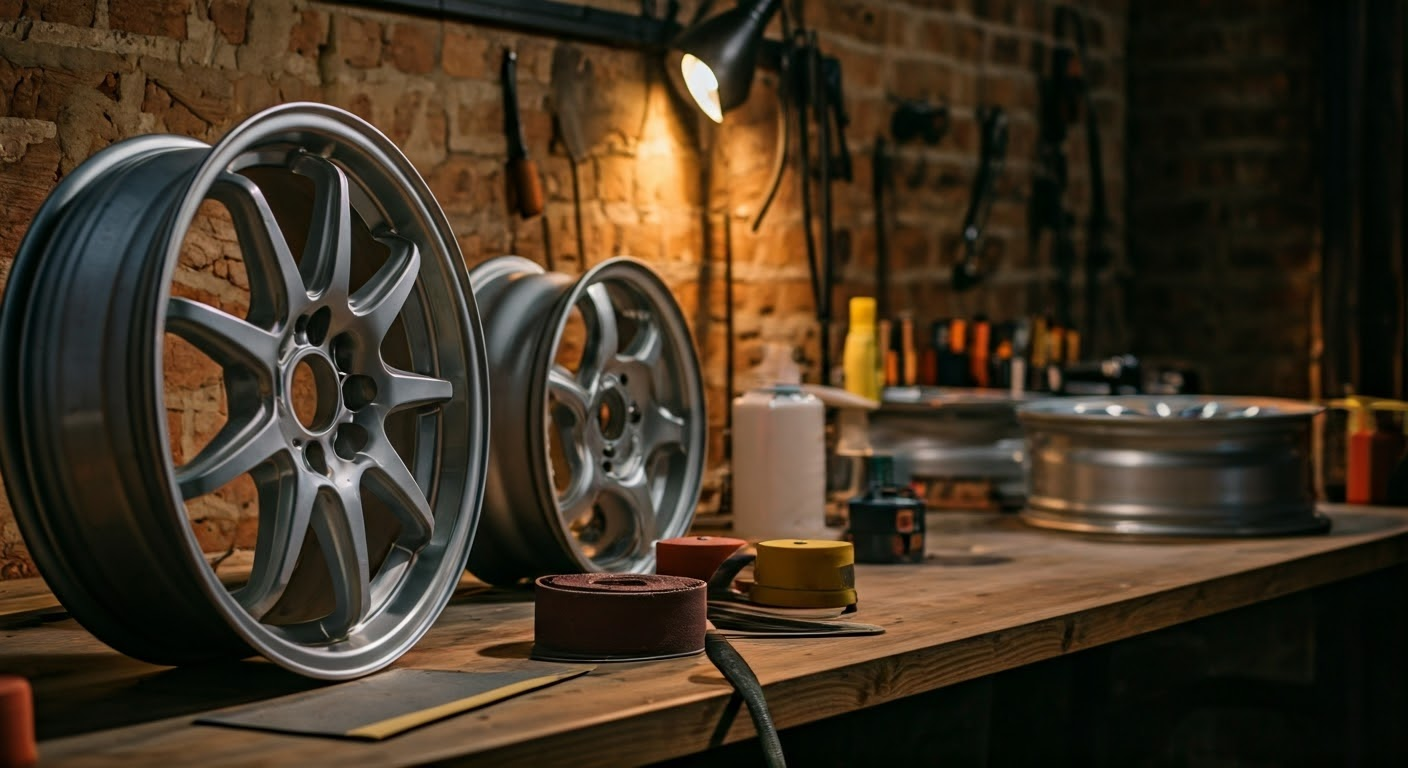Key Highlights
- Sanding and refinishing your aluminum wheels can help them look good and protect them from damage.
- Good sanding is key for a smooth paint job and for the finish to last longer.
- Always choose the right sandpaper grit for every step of sanding.
- It's important to wear proper safety gear, like gloves and a dust mask, when sanding.
- After sanding, priming your wheels makes the paint stick better and gives it a more professional finish.
Introduction
Want to change how your car looks without spending a lot? A DIY wheel paint job is a great choice! Before you start, you need to sand your wheels properly. Good sanding is key. It gives a smooth surface for the primer and paint to stick to. This makes your wheels look amazing. Before you grab your sandpaper and masking tape, let’s go over the main steps and tips for sanding your wheels like a pro!
Understanding Wheel Sanding and Painting

Sanding and polishing are key steps for refinishing your aluminum wheels. With time, your wheels can collect brake dust and grime. They may also get scratches, which can make them look worn. Sanding removes these issues, creating a smoother surface that helps the paint stick well.
Imagine trying to paint a bumpy surface. It won't look good or professional. Sanding smooths the surface. This helps the paint go on smoothly and gives an even finish. After you paint, putting on a clear coat helps protect your wheels. It also makes them shine as if they just came from the showroom!
The Importance of Proper Sanding
Proper sanding is really important for several reasons. First, it removes rust and any imperfections on the wheel's surface. This ensures that the new paint will stick to a clean and smooth area. It also prevents peeling or chipping later on.
Sanding helps make a smooth surface. This is important because it helps the primer and paint stick better. When the paint sticks well, it creates a stronger and longer-lasting finish.
Lastly, a good paint job needs proper sanding. A surface that is well-sanded allows the paint to go on evenly. This gives a smooth and nice finish. If you do not sand well, you may see uneven paint, clear flaws, and a result that does not look good.
Types of Wheels and Paint Compatibility
Different types of wheels need different ways to sand them. Aluminum wheels, found on many cars, need careful care. It is important to use the right grit of sandpaper and the right technique. This will help you avoid damaging the metal.
Clear coat paint is often used on wheels, and it needs good sanding. This ensures the new paint sticks well. You should evenly remove the old clear coat first. Do this before applying primer and new coats of paint.
Always choose a primer that suits your wheel and paint. A good primer helps with adhesion and gives a smooth finish. This creates a professional look. Your nearby auto parts store can assist you in finding the best primer for your needs.
Preparing for the Sanding Process
Before you start sanding, make sure you have the right tools and materials. Getting everything ready will make the job easier. It will help things go smoothly.
It's really important to think about safety when you sand. Wearing the right safety gear helps you stay safe. It also helps to avoid accidents. This way, you can finish your project in a safe and successful way.
Essential Tools and Materials
To get good results when sanding wheels for paint, you will need some tools and materials:
- Sandpaper: Use different grit sandpaper for each sanding step. Start with rough grit, like 220, for the first sanding. Then, switch to finer grits, up to 2000, to get a smooth finish.
- Masking Tape: Use masking tape to cover areas you don’t want to sand or paint, such as the tires or brake parts.
- Cleaning Supplies: Have soap, water, and a degreaser or wax and grease remover ready. You will need these to clean the wheels well before and after sanding.
Metal Polish: A good metal polish can bring back the shine to your aluminum wheels after you sand them.
Getting everything set up before you begin will make sanding and painting quicker and simpler.
Safety Gear and Precautions
Safety is very important when you work on your car. Sanding wheels creates tiny dust particles. Breathing them in can be harmful. To keep your lungs safe, make sure to wear a dust mask.
Also, put on gloves. This will protect your hands from the rough sandpaper. It will also prevent oils and dirt from getting on the wheels while you sand. This is important for a good paint job.
Even simple tasks like sanding can be dangerous if safety rules are not followed. By wearing the right safety gear and following the guidelines, you can make your work area safer. This will help lower the chances of accidents.
Step-by-step Guide to Sanding Wheels for Paint

Now that you understand how important sanding is and what you need to prepare, let's follow a simple guide. This guide will help you sand your wheels for a nice paint job.
Every step is important for achieving a smooth and lasting finish. It’s very important to follow each step carefully. When you put in the effort on every step, you create a beautiful final result.
Step 1: Clean Your Wheels Thoroughly
Before you begin sanding, it's important to clean your wheels properly. Over time, brake dust, grime, and dirt can collect on the surface. This buildup can make the sandpaper less effective and could even cause more scratches on the wheels.
First, clean the wheels with soap and water. This will help remove loose dirt and grime. Next, use a degreaser or a wax and grease remover. This will help get rid of tough brake dust and grease. It is important to remove these items because they can prevent the paint from sticking properly.
After that, rinse the wheels with water. Then, dry them with a soft microfiber cloth. Make sure the wheels are fully dry before you move on. Leftover moisture can cause problems with the sanding and paint adhesion.
Step 2: Remove Any Existing Coatings or Rust
Check your wheels for rust, oxidation, or paint chips. If your wheels have a clear coat, remove it all before you add new paint.
Start by sanding the areas that are damaged. Use coarse grit sandpaper, like 220-grit. Apply even pressure and move the sandpaper back and forth. This will help remove the old coating or rust. If you have aluminum wheels, remember they do not rust, but they can get oxidized. Be sure to deal with any oxidation that you notice.
Keep sanding until you take off most of the unwanted coating. If you have deep scratches or nicks, you may need to use a coarser grit to smooth the surface. Be careful while sanding these spots. You don’t want to take off too much material.
Step 3: Choose the Right Grit Sandpaper
Choosing the right sandpaper grit is key for a great finish. Start with a coarser grit sandpaper, like 300-grit. This helps to smooth out any bumps and make the surface flat.
Wet sanding is a great way to work on aluminum wheels. This method involves soaking the sandpaper in water before you begin. The water cuts down on friction and keeps the sandpaper cleaner. This helps stop any scratching.
As you progress, change to finer grits such as 400, 600, and 800. This will improve the surface even more. Be sure to wash the wheels with water and dry them properly between each grit. This practice prevents coarser grit particles from scratching the surface when using finer grits.
Step 4: Sand the Wheels Evenly
Once you use finer grit sandpaper, such as 600-grit, switch to a circular motion. This method will give you a smooth coating and help lessen sanding marks.
- Apply even pressure while sanding the surface.
- Do not press too hard on one spot.
- The goal is a smooth and steady surface all over the wheel.
If you have deep scratches or flaws, you can use coarser grit sandpaper. Just be careful. Don’t sand too hard. Sanding too hard can remove too much material and make the wheel weaker.
Step 5: Inspect and Repeat Sanding if Necessary
After you sand your wheels, look at them carefully for any remaining marks or mistakes. Shine a bright light on the surface to see it clearly. This will help you spot areas that may need extra attention.
If you notice rough spots, deep scratches, or uneven areas, sand them again using the right grit sandpaper. Focus on the spots where you removed rust or deep scratches. Ensure that the areas you repaired blend well with the rest of the wheel.
When you feel good about how smooth everything is, it's time to clean the wheels. Use soap and water to clean them really well. This will get rid of any sanding dust. After that, let the wheels dry completely before you start painting. Make sure there is no moisture on the surface. If moisture is present, it can affect how well the paint sticks.
After Sanding: Preparing for Painting
Now that you know how to sand your wheels properly, it's time to get ready for the next big step: preparing to paint.
Priming is important to make sure the paint goes on evenly and stays for a long time. Picking the right paint for your wheels is very important too. This helps give a nice and lasting appearance.
Priming Your Wheels for Paint
Applying primer is key before you paint your wheels. It helps the paint stick better. This stops the paint from peeling and chipping. Using primer makes your paint job last longer.
- Make sure to choose a primer made for cars.
- It should match the paint you will use.
- Check that your wheels are clean and dry before getting started.
When you use primer, make sure to apply thin and even coats. Let each coat dry fully before adding another one. You can use masking tape to cover areas you do not want to prime, like the tires or brakes. To stop overspray, hold the spray can far away from the wheel.
Choosing the Right Paint for Your Wheels
Choosing the right paint for your wheels is key. It helps them look good and last longer. Automotive-grade spray paint is a great choice. It is durable and won't fade quickly. Here are some things to think about when choosing paint:
Type:
Paint Type | Description |
Acrylic enamel | This is cheap, easy to use, and has decent durability. It is good if you're on a budget. |
Urethane | This is more durable and resists chips and UV damage. It is a better choice for quality and longevity. |
Powder coat | This is very strong but needs a professional to apply. It gives the toughest finish. |
You can pick from glossy, semi-gloss, satin, or matte finishes. Choose the one that looks best for your car's style.
When you paint, apply several thin coats. Wait for each coat to dry fully before adding the next one. Adding a clear coat is a smart move. It helps protect the paint from UV rays, scratches, and dirt. After the clear coat dries, you can make it shine brighter by adding a layer of wax.
Conclusion
In conclusion, learning how to sand wheels for paint is crucial for a great finish. Good sanding helps paint stick and last longer. Keep these steps in mind:
- Clean your wheels well.
- Remove old coatings.
- Choose the right sandpaper grit.
- Sand evenly.
- Check your work for perfection.
Using primer and the right paint can make your results even better. If you follow these steps closely, you can give your wheels a professional look. If you have any tips or questions, feel free to comment below. Your thoughts can help others on this rewarding journey.
Frequently Asked Questions
What grit sandpaper is best for sanding wheels before painting?
For a good paint job, start with coarse sandpaper, like 220-grit. This will help remove bumps and old paint. Next, use finer grits, such as 300 and 400. You can also choose to do wet sanding if you prefer. Before you begin priming, use a fine grit, like 600-grit or higher, to ensure a smooth finish.
What are the benefits of sanding wheels before painting?
Sanding removes old paint, rust, and marks on the surface. This process makes the area smooth, helping primer and paint stick better. A smooth surface results in a more professional-looking paint job. Sanding also prevents peeling or chipping later on. It protects the surface from corrosion too.
What materials and tools do I need to sand wheels for painting?
You will need several kinds of sandpaper. Have some masking tape to cover the tires and brakes. You should also gather cleaning supplies like soap, water, and degreaser. Don't forget to pick up primer, automotive paint, and clear coat. If needed, add metal polish. Finally, make sure to have safety gear like a dust mask and gloves.
Are there any safety precautions I should take while sanding wheels for painting?
- Always put on a dust mask to stop breathing in sanding dust.
- Use gloves to protect your hands and avoid getting dirt on the wheels.
- Ensure your workspace has good airflow. This lowers dust in the air and helps fumes from paints and primers clear away.






